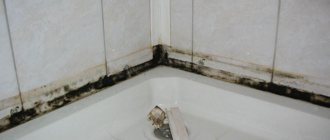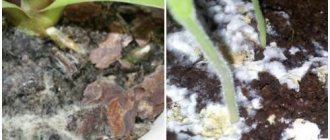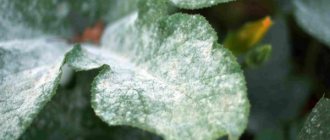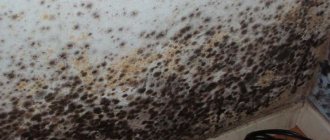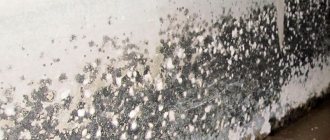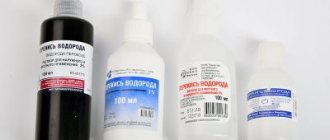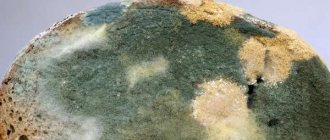Today it is difficult to find an apartment that does not have plastic windows. This is not because such windows are a luxury item, but because former Soviet wooden windows have fallen into disrepair. No one will install new ones, but wooden ones, since everyone knows what problems can arise. They do not retain noise, dry out over time and begin, as they say, to “breathe to the fullest.” This leads to the fact that heat is not retained in the apartment, which is now worth its weight in gold. It's different - plastic windows! They block noise, and their durability is estimated at tens of years. In addition, they are practical, as they require virtually no maintenance.
Unfortunately, there are times when mold appears on the frame of a plastic window and on the slope. The conditions for mold growth are high humidity and a temperature of about +15 degrees. Although mold is not capable of damaging the structure of plastic windows, it is considered harmful to human health, especially for people with weak immunity. Therefore, the appearance of mold should serve as a serious warning to apartment residents.
Risk factors
There are several reasons why mold appears on plastic windows:
- The installation of double-glazed windows was carried out in violation of technology.
- High level of humidity in the room.
- Lack of ventilation.
- The presence of a wide window sill, which impedes the movement of warm air currents tending to the window.
- Insufficient thermal insulation of the walls of the house.
These and other factors provoke the development of fungus on windows, providing favorable conditions for the active growth and activity of microorganisms. It should be borne in mind that at the initial stage the problem may not have visual manifestations. Even before brown, green and black spots appear on the windowsill and slopes, a characteristic musty smell appears in the room, which no air freshener can cope with.
Conditions for mold to appear on windows
Fungal spores are always present in the air, but they do not show their activity until they can get into comfortable conditions. Fungus appears quite often on plastic windows.
There are a number of reasons when mold appears on plastic windows:
- Lack of proper air exchange in the home . Everyone knows that plastic does not allow moisture or air to pass through. When there is no circulation of fresh air, stagnation of air masses results, which leads to the appearance and further proliferation of mold. First, black dots appear on slopes, which quickly transform into black, extensive spots.
- High humidity . Due to the fact that plastic does not absorb moisture, condensation often forms on them, which contributes to the growth of fungus. The fungus begins to feel good already at a humidity of about 60%. Factors such as lack or poor ventilation, as well as improper installation of windows, contribute to the appearance of high humidity and condensation.
Fungus is one of those microorganisms that is almost impossible to destroy. They can remain in a state of hibernation for millennia, and when favorable conditions appear, they immediately begin to actively reproduce. It has long been known that mold has a negative effect on humans. If you breathe in fungal spores for a long time, this can lead to serious, sometimes incurable diseases. Mold is especially dangerous for people prone to allergies, as well as people with a number of respiratory diseases.
Step by step solution to the problem
You need to understand that mold on plastic windows is not enough to simply wash off. Solving the problem must be approached comprehensively, otherwise there is a risk that the fungus will soon return again. To prevent this from happening, we must call on all available methods and means to help.
Eliminate the root cause
The fight against mold should always begin with eliminating the root cause - the source of high humidity. Otherwise, all efforts will be in vain, and the fungus will appear with enviable regularity.
First of all, it is necessary to determine why the windows become moldy and carefully evaluate their condition. If condensation regularly forms on them, the installation was carried out in violation of the process technology. Poor installation leads to deformation and displacement of the frame, errors in measurements lead to insufficient thermal insulation. Constant humidity is an ideal environment for fungi and other microorganisms, so if the source of dampness is not eliminated, it will not be possible to completely get rid of mold on windows. The best option in this case is to replace or reinstall double-glazed windows.
If during the inspection of the window no defects are identified, the problem is in the room itself. If the humidity level in the room exceeds 60%, it is necessary to immediately reduce the levels and establish air exchange.
Cleaning stains
After the source of dampness has been eliminated, you can begin to remove mold stains from the surface of window frames, window sills and slopes. This must be done carefully, without missing a single centimeter, since the spores are very tenacious and love secluded places. Superficial treatment will not save the situation - the fungus will grow again.
The most difficult thing to eliminate is mold that has formed on window slopes. As a rule, they are made of plasterboard - a porous material that turns into a real breeding ground for pathogenic microorganisms. In this case, there is no alternative; a complete replacement of the finishing sheets will be required, followed by treating the wall surface with special antifungal compounds. The exception is plastic slopes - they can be washed using the same means as the rest of the window parts.
You can remove black stains using accessible and inexpensive household chemicals. They can be found at any hardware store. The main thing to remember is that these substances are quite aggressive, so you need to take precautions when working with them. Among the most effective are:
- Chlorine-containing preparations. They help both get rid of mold on the windowsill and window frame, and disinfect the room. They should be diluted with water in a ratio of 1:5, after which the mold should be thoroughly washed with a sponge soaked in the solution. When working with bleach, you must protect your hands with gloves and use a respirator.
- Copper sulfate is an effective remedy that can be found in gardening shops and supermarkets. With its help, it is easy to wash even extensive stains; you just need to apply it to a sponge and wipe the surface affected by the fungus. As in the case of bleach, you should protect your hands and respiratory tract from contact with the substance, and the room should be thoroughly ventilated.
- Baking soda is a remedy that does not give the fungus a single chance. You will need to mix 100 g of powder with 300 ml of water, stir thoroughly, then apply the solution to the stain using a sponge and wipe.
- Table vinegar will also help get rid of mold on windows. First, you need to wipe the stains with a dry cloth, and then apply undiluted vinegar to them. After two hours, surfaces should be rinsed with clean water. If the contamination cannot be removed the first time, the procedure can be repeated.
Cleaners such as Dufa, Vincents and Polyline are not recommended as PVC will turn yellow on contact with them.
How to remove mold from window slopes. How to remove mold from windows?
In order to remove black mold stains from plastic surfaces, you can use folk or industrial remedies. It won't be that difficult to do. The most important thing during such cleaning is to take into account what material the profile is made of and not to use too aggressive chemicals in the fight against mold.
Traditional methods
The choice here is quite wide:
- 9% vinegar works great against mold. Apply it (without diluting) to the affected area for one hour and then rinse with water.
- Baking soda and hydrogen peroxide can remove mold from a white profile (it is better not to use this method for colored people, as peroxide can affect the brightness of the color). Mix soda with water and apply the resulting slurry to the surface to be cleaned. Spray hydrogen peroxide from a spray bottle on top. After the reaction stops, wipe the profile with a clean damp cloth.
- Another way to use soda in the fight against mold is to prepare a solution based on it (you will need 4 tablespoons for one liter of water) and rinse mold-affected surfaces with it.
- Tea tree oil is an effective antiseptic. Prepare such a solution - mix one teaspoon of salt and oil, add one glass of water to them and mix thoroughly until the salt is completely dissolved. Wash all surfaces of the window with the resulting product. There is no need to wash it off, since this product not only destroys mold, but also has a preventive effect.
- Another method is not as safe as the previous ones. Copper sulfate is used here in combination with bleach. You should work with these drugs in a well-ventilated room, after wearing rubber gloves. Add 100 ml of bleach and copper sulfate to one liter of water. Treat the mold with the resulting solution, and after 5 minutes, rinse the affected area with water.
Additional measures
To prevent mold from reappearing on windows, windowsills and slopes, fungicides – substances that stop the growth of mold fungi – should be used in combination with detergents. These include “Biocid”, “Clotrimazole”, “NEOMide” and other drugs. You can buy them at your nearest pharmacy and use them according to the instructions on the package.
We recommend:
How to remove grease stains from suede
Coating the wall areas adjacent to the window with special waterproofing agents - mastic or rubber-based primer - will help to consolidate the result. This will create a moisture-proof barrier that will reliably protect the room from moisture from the outside.
Important! To apply the waterproofing compound evenly, use a wide silicone brush.
Technology to help
An ultraviolet lamp also helps fight mold that appears on window frames, window sills and walls. Studies have shown that its rays effectively destroy almost all types of pathogenic microorganisms, which include fungal spores. Therefore, such a household appliance can be used regularly for preventive purposes. The main thing is to follow the precautions prescribed in the instructions. In particular, do not stay in the room while the device is operating and ventilate the room after treatment is completed.
Ozonizer
An ozonizer is another indispensable assistant in the fight against germs, mold and dust mites. Within an hour of operation, the device is able to completely clean the room of pathogenic organisms. But it should be remembered that ozone in high concentrations has a poisonous effect, so you should not be near a working device, and after finishing the treatment, the room must be thoroughly ventilated.
Prevention of occurrence
Prevention is of utmost importance in the battle against mold. To prevent the fungus from returning, you must follow these recommendations:
Ventilate the room at least once a day.- Air humidity control. To do this, you can purchase a hygrometer; the readings on it should not exceed 33-35%.
- The kitchen must have a hood; it is the condensation formed during cooking that provokes the appearance of fungus.
- Maintain the optimal air temperature in the room within 22-25°C.
- If the windows fog up, wipe them regularly with a dry cloth.
- Periodically wipe window sills and window frames with water containing chlorine. This will not only prevent the formation of mold, but will also have a disinfecting effect in general.
The presence of curtains on the windows and the density of the material from which they are made are of great importance.
Constantly closed curtains made of heavy fabrics do not allow the room to be fully ventilated; increased humidity occurs between the curtain and the window, which is one of the factors in the appearance of fungus.
Preventive actions
To avoid the reappearance of mold on plastic windows and other surfaces, be sure to ensure good air circulation in the room. It will be necessary to establish a ventilation system, as well as remove all sources of moisture - indoor flowers that require regular watering, containers with water, wet laundry. And, of course, you need to repair the heating system if even a minor leak is discovered. Only by eliminating all negative factors can you count on long-term results.
Rate this post
